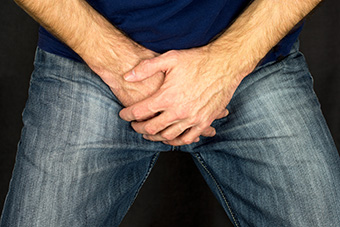Peyronie’s disease (PD) is an acquired fibrotic condition of the penis where a plaque (scar) develops under the skin of the penis, often leading to penile deformity, painful erections, and erectile dysfunction.
The plaque consists of scar tissue that forms within the wall of the tissue called the tunica albuginea that surrounds the corpus cavernosum, which is the structure that fills with blood to create erections. When the plaque is large enough, it causes contracture/curvature of the penis which may be painful and may prevent intercourse. The plaque may also cause erections to be less rigid or difficult to maintain. PD is common and may run in families, with an estimated 4-7% of all men having some degree of PD.
The exact cause of Peyronie’s disease is unknown, but it is likely that a genetic predisposition to abnormal scar tissue formation is an underlying cause. In some men, PD is caused by trauma to the penis, such as sudden and painful bending during intercourse. Peyronie’s disease can be associated with abnormal scar tissue formation in the plantar fascia of the foot (Ledderhose disease), the eardrum (tympanosclerosis), or the palm of the hand (Dupuytren’s contracture). Low testosterone, or hypogonadism, is also commonly seen in men with PD, which may pre-dispose to poor wound healing and inflammation.

Symptoms and Diagnosis of Peyronie’s Disease
Peyronie’s disease often begins with the sudden onset of curvature to the erect penis, which may initially be painful. PD may present with the new onset of erectile dysfunction (ED). You or your doctor may notice an abnormal hardening or calcification of the tissue beneath the penile skin along the shaft of your penis. The plaque commonly occurs on the upper side of the penis near the base, but can also form on the bottom or side of the penis. In some men, the plaque occurs around the entire penis, creating a “bottle-neck” or circumferential deformity. PD is usually asymptomatic in the flaccid state.
During erection, there may be:
- A bend in the penis
- Penile pain from the erection or pain during intercourse
- Pain with intercourse for the sexual partner
- Difficulty with penetration
- Shortening of the penis
- Inability to maintain the erection
- Narrowing of a portion of the penile shaft, which is called an “bottle-neck” or “hourglass deformity”
Ultrasound can be used to evaluate the size of the plaque, the degree of penile curvature and severity of associated ED. To perform this ultrasound study, medicine is injected into the penis to produce an erection. A painless ultrasound probe is used to determine the characteristics of the plaque, degree of curvature, arterial blood flow into the penis, and the ability of the veins to keep this blood from exiting the penis. This information is used to develop an individualized treatment plan.
Treatment for Peyronie’s Disease
A combination of oral medications and/or penile injections may improve the symptoms of Peyronie’s Disease. A vacuum erection device (VED) may be beneficial to improve penile length or aid with erections if venous leak erectile dysfunction is detected on ultrasound. For a small percentage of men, the curvature can improve over time with or without treatment.
Oral Medications:
The following medications may alleviate some symptoms or slow the progression of Peyronie’s disease:
- Trental (pentoxifylline)
- L-Arginine
- Vitamin E
- Daily phosphodiesterase inhibitor (e.g., Viagra/Cialis)
Injection therapy:
XIAFLEX® (Collagenase clostridium histolyticum) injections are currently approved by the FDA and endorsed by the Sexual Medicine Society of North America for the treatment of Peyronie’s disease. This therapy has specific criteria; talk to your treating physician to see if injection therapy is a good option for you.
Surgical Repair
Surgical treatment is typically reserved for men with a severe penile curvature or ED that prevents intercourse. The main goal of surgery is to straighten the penis enough to restore satisfactory sexual function.
Surgical procedures for men with severe curvature but preserved erection function may include:
- Plication: This procedure involves placement of nonabsorbable sutures into the tissues of the penis opposite the curve. Although it causes some shortening of the erect penis, it has the lowest risk of subsequent erectile dysfunction.
- Incision and Grafting: In this procedure, the Peyronie’s plaque is incised and replaced with a tissue graft.
- Extra-tunical Grafting: This procedure is reserved for rare cases of bottle-neck deformities. Depending on the penile anatomy, bolstering the outside of the tunica albuginea, while leaving the Peyronie’s plaque alone, may create a symmetric-appearing penis during the erect state.
Penile Prosthesis
For men with PD and ED not responsive to conservative treatment options, implantation of a penile prosthesis is the best option. A penile prosthesis completely cures both disorders by restoring sexual function, straightens penis, and restores the spontaneity of sex. It is often considered the most successful and durable treatment for ED. Performed through a small incision, a penile implant is invisible in your body while replicating a natural erection and sexual experience. Sensation, orgasm, ejaculation, and urination are all unaffected. The prosthesis has the highest success rate of all the treatments for Peyronie’s disease and erectile dysfunction, and over 90% of men and their partners have reported satisfaction after the procedure. There are two main types of penile prosthesis: inflatable and malleable. An inflatable penile prosthesis consists of 3 components that allows for a normal flaccid state, and then inflation through a scrotal pump produces a rigid state. A malleable penile prosthesis exists in a permanent semirigid state that bends downwards for urination and bends upwards for sexual activity.
There are clearly a number of treatment options for any form of Peyronie’s disease. Call AUI’s scheduling line at 727-441-1508 to schedule an appointment with your local sexual health expert, and start your journey toward a more satisfying sex life.
